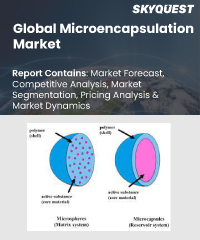
Report ID: SQMIG30L2167

Report ID:
SQMIG30L2167 |
Region:
Global |
Published Date: February, 2024
Pages:
157
|
Tables:
69 |
Figures:
75
Microencapsulation Market size was valued at USD 11.1 billion in 2021 and is poised to grow from USD 12.52 billion in 2022 to USD 32.28 billion by 2030, growing at a CAGR of 12.8% in the forecast period (2023-2030).
The global microencapsulation oxides market is experiencing significant growth and is expected to continue its upward trajectory in the coming years. One of the key factors driving the growth of the global microencapsulation oxides market is the increasing demand from industries such as pharmaceuticals, food and beverages, personal care, and agrochemicals. In the pharmaceutical industry, microencapsulation oxides are widely utilised for drug delivery systems, allowing controlled and targeted release of medications. This technology enables the protection of sensitive drugs from degradation, improves bioavailability, and provides sustained release profiles, leading to enhanced therapeutic efficacy. Moreover, the rising demand for personalised medicine and the development of novel drug delivery techniques are further fueling the adoption of microencapsulation oxides in the pharmaceutical sector.
The food and beverage industry is another major consumer of microencapsulation oxides. These encapsulated particles are used to enhance the stability and functional properties of food ingredients, such as flavours, vitamins, antioxidants, and nutraceuticals. Microencapsulation provides improved protection against environmental factors, such as light, heat, and moisture, thereby extending the shelf life and maintaining the quality of food products. Additionally, it allows for the controlled release of flavours or active ingredients, leading to enhanced taste experiences and targeted functional benefits.
In the personal care industry, microencapsulation oxides find applications in skincare, hair care, and cosmetic products. Encapsulated particles are utilised to improve the stability, controlled release, and efficacy of active ingredients, such as vitamins, sunscreens, fragrances, and anti-aging compounds. Microencapsulation technology enables the protection of these sensitive ingredients from degradation caused by exposure to light, air, or other external factors, thereby increasing their effectiveness in personal care formulations. The agrochemical sector is also witnessing a growing demand for microencapsulation oxides. Encapsulated agrochemicals, such as pesticides, herbicides, and fertilisers, offer improved efficiency, reduced environmental impact, and controlled release, resulting in better crop yield and reduced chemical leaching. Microencapsulation technology allows for targeted delivery and sustained release of active ingredients, ensuring their proper utilisation and minimising losses due to volatilization or runoff.
US Microencapsulation Market is poised to grow at a sustainable CAGR for the next forecast year.
Our industry expert will work with you to provide you with customized data in a short amount of time.
REQUEST FREE CUSTOMIZATIONWant to customize this report? This report can be personalized according to your needs. Our analysts and industry experts will work directly with you to understand your requirements and provide you with customized data in a short amount of time. We offer $1000 worth of FREE customization at the time of purchase.

Report ID: SQMIG30L2167